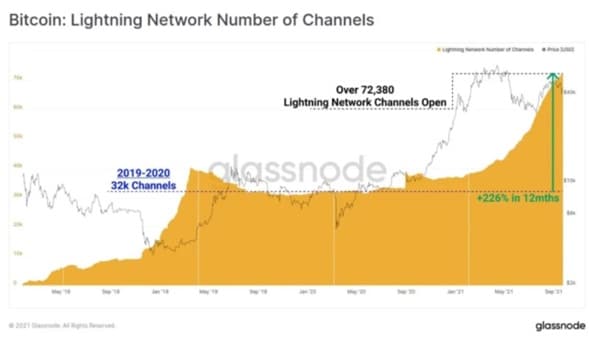Key facts:
- 2,800 bitcoins, about 0.02% of the total circulating, are blocked on the Lightning network.
- So far in September 2021 alone, the Lightning network has grown 10%.
The Bitcoin Lightning Network (BTC), which allows immediate payments and very low fees, continues to grow. The network has reached all-time highs, both in adoption and in number of blocked BTCs. In these parameters, growth has been more than 200% in the last year.
If you look at the current numbers, it can be seen that both the number of nodes and the number of active channels have grown considerably. More than 200% and 100%, respectively, in the last 12 months .
In the case of pay channels, the figure currently stands at over 72 thousand public channels, not counting private channels. This, in relation to the 32 thousand that were in September of last year represents a growth of 226%.


In the case of the amount of BTC blocked within the Lightning network, the figure already reaches 2,800 BTC with a market value of just over USD 100 million
In relation to September of last year, the growth was 258% going from 1,100 BTC blocked to the current figure. It is worth noting a boost of 22% of blocked BTC only in the month of September .


In the case of the new nodes that have joined the network, the figure is currently over 15 thousand . An increase of 50% since April of this year, and 100% since September 2020.


A payment channel, is a means of transaction, outside the blockchain, in which two people commit funds in one direction, allowing them to make exchanges between pairs, without being directly established on the Bitcoin blockchain.
The nodes , on the other hand, basically correspond to a computer or server, which keeps a copy of the entire network, and is responsible for routing payments to the destination address. A decentralized network is made up of multiple nodes, as is the case with Bitcoin, spread all over the world.
Also Check: Twitter: introducing Bitcoin payment feature on its platform
Technological growth of the Lightning network
The growth of the Bitcoin Lightning network is not only measured in the number of nodes and channels, but also in technological development. This year, the developers of the Lightning network have presented several innovations that represent significant improvements within this protocol.
In May, this media reported the implementation of an update that will allow opening payment channels with third-party financing. This gives users the ability to send and receive payments over the network, without the need to lock their funds before using them.
By June, news broke that reusable invoices would become available within the network , specifically for the Lightning Network Daemon client. This allows a payment invoice, which is the counterpart of what a wallet address would be on the Bitcoin network, to have no expiration date. This allows to improve the user experience within this second layer Bitcoin solution. (More: China’s opposition to crypto is a great opportunity for the US)
Adoption of the Lightning network
In addition, implementations are being developed that favor the adoption of the Lightning network. For example, before yesterday Twitter enabled a BTC tipping system within its social network with the integration of Strike, which uses Bitcoin and the Lightning network to send and receive funds.
Another platform that facilitates the use of the network of payment channels is Paxful, a P2P exchange, which a few days ago enabled the function of receiving and withdrawing BTC through Lightning .
However, some specialists estimate that the Bitcoin Lightning network is still a long way from its mass adoption at the infrastructure level. Developments in this area are necessary so that the network can support the massive demand for transactions that will occur when it is massively adopted by large platforms, for example, exchanges or marketplaces that accept BTC.

